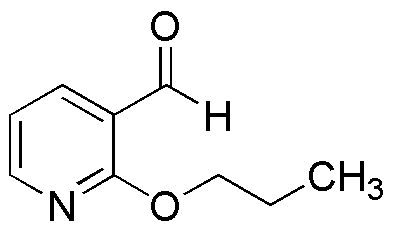2-Propoxy-pyridine-3-carbaldehyde is widely utilized in research focused on:
- Synthesis of Pharmaceuticals: This compound serves as an important intermediate in the synthesis of various pharmaceutical agents, particularly those targeting neurological disorders.
- Agricultural Chemicals: It is used in the development of agrochemicals, enhancing the efficacy of crop protection products by acting as a building block for more complex molecules.
- Flavor and Fragrance Industry: The compound is employed in creating specific flavor profiles and fragrances, offering a unique aromatic quality that can enhance consumer products.
- Research in Organic Chemistry: It is a valuable reagent in organic synthesis, allowing researchers to explore new chemical reactions and develop innovative materials.
- Material Science: This chemical is being investigated for its potential use in developing advanced materials, such as polymers with specific functional properties.
General Information
Properties
Safety and Regulations
Applications
2-Propoxy-pyridine-3-carbaldehyde is widely utilized in research focused on:
- Synthesis of Pharmaceuticals: This compound serves as an important intermediate in the synthesis of various pharmaceutical agents, particularly those targeting neurological disorders.
- Agricultural Chemicals: It is used in the development of agrochemicals, enhancing the efficacy of crop protection products by acting as a building block for more complex molecules.
- Flavor and Fragrance Industry: The compound is employed in creating specific flavor profiles and fragrances, offering a unique aromatic quality that can enhance consumer products.
- Research in Organic Chemistry: It is a valuable reagent in organic synthesis, allowing researchers to explore new chemical reactions and develop innovative materials.
- Material Science: This chemical is being investigated for its potential use in developing advanced materials, such as polymers with specific functional properties.
Documents
Safety Data Sheets (SDS)
The SDS provides comprehensive safety information on handling, storage, and disposal of the product.
Product Specification (PS)
The PS provides a comprehensive breakdown of the product’s properties, including chemical composition, physical state, purity, and storage requirements. It also details acceptable quality ranges and the product's intended applications.
Certificates of Analysis (COA)
Search for Certificates of Analysis (COA) by entering the products Lot Number. Lot and Batch Numbers can be found on a product’s label following the words ‘Lot’ or ‘Batch’.
*Catalog Number
*Lot Number
Certificates Of Origin (COO)
This COO confirms the country where the product was manufactured, and also details the materials and components used in it and whether it is derived from natural, synthetic, or other specific sources. This certificate may be required for customs, trade, and regulatory compliance.
*Catalog Number
*Lot Number
Safety Data Sheets (SDS)
The SDS provides comprehensive safety information on handling, storage, and disposal of the product.
DownloadProduct Specification (PS)
The PS provides a comprehensive breakdown of the product’s properties, including chemical composition, physical state, purity, and storage requirements. It also details acceptable quality ranges and the product's intended applications.
DownloadCertificates of Analysis (COA)
Search for Certificates of Analysis (COA) by entering the products Lot Number. Lot and Batch Numbers can be found on a product’s label following the words ‘Lot’ or ‘Batch’.
*Catalog Number
*Lot Number
Certificates Of Origin (COO)
This COO confirms the country where the product was manufactured, and also details the materials and components used in it and whether it is derived from natural, synthetic, or other specific sources. This certificate may be required for customs, trade, and regulatory compliance.


